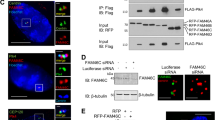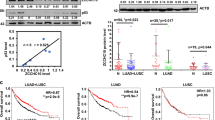Abstract
The human INK4a locus encodes two structurally unrelated tumor suppressor proteins, p16INK4a and p14ARF (p19ARF in the mouse), which are frequently inactivated in human cancer. Both the proapoptotic and cell cycle-regulatory functions of p14ARF were initially proposed to be strictly dependent on a functional p53/mdm-2 tumor suppressor pathway. However, a number of recent reports have implicated p53-independent mechanisms in the regulation of cell cycle arrest and apoptosis induction by p14ARF. Here, we show that the G1 cell cycle arrest induced by p14ARF entirely depends on both p53 and p21 in human HCT116 and DU145 carcinoma cells. In contrast, neither loss of p53 nor p21 impaired apoptosis induction by p14ARF as evidenced by nuclear DNA fragmentation, phosphatidyl serine exposure, and caspase activation, which included caspase-3/7- and caspase-9-like activities. However, lack of functional p21 resulted in the accumulation of cells in G2/M phase of the cell cycle and markedly enhanced p14ARF-induced apoptosis that was, nevertheless, efficiently inhibited by the cell permeable broad-spectrum caspase inhibitor zVAD-fmk (valyl-alanyl-aspartyl-(O)-methyl)-fluoromethylketone). Thus, loss of cell cycle restriction point control in the absence of p21 may interfere with p14ARF-induced apoptosis. Finally, these data indicate that the signaling events required for G1 cell cycle arrest and apoptosis induction by p14ARF dissociate upstream of p53.
This is a preview of subscription content, access via your institution
Access options
Subscribe to this journal
Receive 50 print issues and online access
$259.00 per year
only $5.18 per issue
Buy this article
- Purchase on Springer Link
- Instant access to full article PDF
Prices may be subject to local taxes which are calculated during checkout











Similar content being viewed by others
References
Bissonnette N and Hunting DJ . (1998). Oncogene, 16, 3461–3469.
Bunz F, Dutriaux A, Lengauer C, Waldman T, Zhou S, Brown JP, Sedivy JM, Kinzler KW and Vogelstein B . (1998). Science, 282, 1497–1501.
Carnero A, Hudson JD, Price CM and Beach DH . (2000). Nat. Cell Biol., 2, 148–155.
Cleveland JL and Sherr CJ . (2004). Cancer Cell, 6, 309–311.
Craig C, Kim M, Ohri E, Wersto R, Katayose D, Li Z, Choi YH, Mudahar B, Srivastava S, Seth P and Cowan K . (1998). Oncogene, 16, 265–272.
Daniel PT . (2000). Leukemia, 14, 2035–2044.
Daniel PT, Schulze-Osthoff K, Belka C and Güner D . (2003). Essays Biochem., 39, 73–88.
Daniel PT, Sturm I, Ritschel S, Friedrich K, Dörken B, Bendzko P and Hillebrand T . (1999). Anal. Biochem., 266, 110–115.
de Stanchina E, McCurrach ME, Zindy F, Shieh SY, Ferbeyre G, Samuelson AV, Prives C, Roussel MF, Sherr CJ and Lowe SW . (1998). Genes Dev., 12, 2434–2442.
Donato NJ and Perez M . (1998). J. Biol. Chem., 273, 5067–5072.
Duro D, Bernard O, Della Valle V, Berger R and Larsen CJ . (1995). Oncogene, 11, 21–29.
Eischen CM, Weber JD, Roussel MF, Sherr CJ and Cleveland JL . (1999). Genes Dev., 13, 2658–2669.
Eymin B, Karayan L, Seite P, Brambilla C, Brambilla E, Larsen CJ and Gazzeri S . (2001). Oncogene, 20, 1033–1041.
Eymin B, Leduc C, Coll JL, Brambilla E and Gazzeri S . (2003). Oncogene, 22, 1822–1835.
Fotedar R, Brickner H, Saadatmandi N, Rousselle T, Diederich L, Munshi A, Jung B, Reed JC and Fotedar A . (1999). Oncogene, 18, 3652–3658.
Gillissen B, Essmann F, Graupner V, Starck L, Radetzki S, Dörken B, Schulze-Osthoff K and Daniel PT . (2003). EMBO J., 22, 3580–3590.
Groth A, Weber JD, Willumsen BM, Sherr CJ and Roussel MF . (2000). J. Biol. Chem., 275, 27473–27480.
Güner D, Belka C and Daniel PT . (2003). Curr. Med. Chem. Anti-Cancer Agents, 3, 319–326.
Hemmati PG, Gillissen B, von Haefen C, Wendt J, Starck L, Güner D, Dörken B and Daniel PT . (2002). Oncogene, 21, 3149–3161.
Kokontis JM, Wagner AJ, O'Leary M, Liao S and Hay N . (2001). Oncogene, 20, 659–668.
Kuo ML, Duncavage EJ, Mathew R, den Besten W, Pei D, Naeve D, Yamamoto T, Cheng C, Sherr CJ and Roussel MF . (2003). Cancer Res., 63, 1046–1053.
Mahyar-Roemer M and Roemer K . (2001). Oncogene, 20, 3387–3398.
Mao L, Merlo A, Bedi G, Shapiro GI, Edwards CD, Rollins BJ and Sidransky D . (1995). Cancer Res., 55, 2995–2997.
Martelli F, Hamilton T, Silver DP, Sharpless NE, Bardeesy N, Rokas M, DePinho RA, Livingston DM and Grossman SR . (2001). Proc. Natl. Acad. Sci. USA, 98, 4455–4460.
Mason SL, Loughran O and La Thangue NB . (2002). Oncogene, 21, 4220–4230.
Modestou M, Puig-Antich V, Korgaonkar C, Eapen A and Quelle DE . (2001). Cancer Res. 61, 3145–3150.
Normand G, Hemmati PG, Verdoodt B, von Haefen C, Wendt J, Güner D, May E, Dörken B and Daniel PT . (2004). J. Biol. Chem., 6 Dec 2004; [Epub ahead of print].
Palmero I, Pantoja C and Serrano M . (1998). Nature, 395, 125–126.
Pennington KN, Taylor JA, Bren GD and Paya CV . (2001). Mol. Cell. Biol., 21, 1930–1941.
Pomerantz J, Schreiber-Agus N, Liegeois NJ, Silverman A, Alland L, Chin L, Potes J, Chen K, Orlow I, Lee HW, Cordon-Cardo C and DePinho RA . (1998). Cell, 92, 713–723.
Qi Y, Gregory MA, Li Z, Brousal JP, West K and Hann SR . (2004). Nature, 431, 712–717.
Quelle DE, Zindy F, Ashmun RA and Sherr CJ . (1995). Cell, 83, 993–1000.
Radfar A, Unnikrishnan I, Lee HW, DePinho RA and Rosenberg N . (1998). Proc. Natl. Acad. Sci. USA, 95, 13194–13199.
Rau B, Sturm I, Lage H, Berger S, Schneider U, Hauptmann S, Wust P, Riess H, Schlag PM, Dörken B and Daniel PT . (2003). J. Clin. Oncol., 21, 3391–3401.
Rowland BD, Denissov SG, Douma S, Stunnenberg HG, Bernards R and Peeper DS . (2002). Cancer Cell., 2, 55–65.
Schmitt CA, McCurrach ME, de Stanchina E, Wallace-Brodeur RR and Lowe SW . (1999). Genes Dev., 13, 2670–2677.
Scholz C, Starck L, Willimsky G, Blankenstein T, Dörken B and Daniel PT . (2002). Gene. Ther., 9, 1438–1446.
Sherr CJ . (2001). Nat. Rev. Mol. Cell. Biol., 2, 731–737.
Stone S, Jiang P, Dayananth P, Tavtigian SV, Katcher H, Parry D, Peters G and Kamb A . (1995). Cancer Res., 55, 2988–2994.
Stott FJ, Bates S, James MC, McConnell BB, Starborg M, Brookes S, Palmero I, Ryan K, Hara E, Vousden KH and Peters G . (1998). EMBO J., 17, 5001–5014.
Voorhoeve PM and Agami R . (2003). Cancer Cell, 4, 311–319.
Waldman T, Kinzler KW and Vogelstein B . (1995). Cancer Res., 55, 5187–5190.
Weber HO, Samuel T, Rauch P and Funk JO . (2002). Oncogene, 21, 3207–3212.
Weber JD, Jeffers JR, Rehg JE, Randle DH, Lozano G, Roussel MF, Sherr CJ and Zambetti GP . (2000). Genes Dev., 14, 2358–2365.
Yarbrough WG, Bessho M, Zanation A, Bisi JE and Xiong Y . (2002). Cancer Res., 62, 1171–1177.
Zhang Y, Fujita N and Tsuruo T . (1999). Oncogene, 18, 1131–1138.
Zhu J, Jiang J, Zhou W and Chen X . (1998). Cancer Res., 58, 5061–5065.
Zindy F, Eischen CM, Randle DH, Kamijo T, Cleveland JL, Sherr CJ and Roussel MF . (1998). Genes Dev., 12, 2424–2433.
Zindy F, Williams RT, Baudino TA, Rehg JE, Skapek SX, Cleveland JL, Roussel MF and Sherr CJ . (2003). Proc. Natl. Acad. Sci. USA, 100, 15930–15935.
Acknowledgements
This work was supported by the Deutsche Krebshilfe Grant 10-2088-Da3 to PTD and PGH. We would like to thank Antje and Anja Richter and Jana Rossius for expert technical assistance. HCT116 cells were generously provided by Dr Bert Vogelstein, Johns Hopkins Cancer Center, Baltimore, MD, USA.
Author information
Authors and Affiliations
Corresponding author
Rights and permissions
About this article
Cite this article
Hemmati, P., Normand, G., Verdoodt, B. et al. Loss of p21 disrupts p14ARF-induced G1 cell cycle arrest but augments p14ARF-induced apoptosis in human carcinoma cells. Oncogene 24, 4114–4128 (2005). https://doi.org/10.1038/sj.onc.1208579
Received:
Revised:
Accepted:
Published:
Issue Date:
DOI: https://doi.org/10.1038/sj.onc.1208579
Keywords
This article is cited by
-
Roles of ARF tumour suppressor protein in lung cancer: time to hit the nail on the head!
Molecular and Cellular Biochemistry (2021)
-
Defined factors to reactivate cell cycle activity in adult mouse cardiomyocytes
Scientific Reports (2019)
-
Mitochondrial pathway mediated apoptosis and cell cycle arrest triggered by aqueous extract of wheatgrass in colon cancer colo-205 cells
Journal of Plant Biochemistry and Biotechnology (2016)
-
Apoptosis resistance, mitotic catastrophe, and loss of ploidy control in Burkitt lymphoma
Journal of Molecular Medicine (2015)
-
Modelling the onset of senescence at the G1/S cell cycle checkpoint
BMC Genomics (2014)



